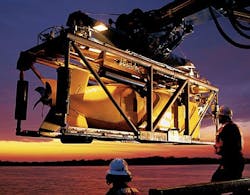NexTech joins Lynntech in project to develop prototype propulsion and power system for future long-endurance UUVs
ARLINGTON, Va., 7 June 2012.Unmanned underwater vehicle (UUV) experts at the U.S. Office of Naval Research (ONR) in Arlington, Va., are asking engineers at NexTech Materials Ltd. in Lewis Center, Ohio, to develop a prototype propulsion and power system for a future long-endurance UUV under terms of an $18 million contract awarded Monday.
ONR is asking NexTech over the next 18 months to develop a prototype UUV propulsion system that measures 30 inches long by 18.5 inches in diameter that delivers 42 to 68 kilowatt hours of power for at least 30 hours. The project is part of ONR's Long Endurance Undersea Vehicle Propulsion research program (story continues below).
NexTech joins Lynntech Inc. in College Station, Texas, on the ONR project to long-endurance UUV power and propulsion as part of the Long Endurance Undersea Vehicle Propulsion research program. Lynntech also won an $18 million ONR on 23 May to develop a prototype UUV power and propulsion system.
Navy UUV designers are asking industry to develop technology to extend the endurance of future UUVs from the current 10 to 40 hours to several days or weeks, ONR researchers say. Today's high-energy density batteries alone are not up to the task, so the Navy is asking Lynntech to develop solutions beyond battery-only technology.
NexTech Materials specializes in high-performance complex oxides for solid-oxide fuel cell (SOFC) and catalysis applications. The company has a dedicated pilot facility to build SOFCs and electrochemical sensors.
Lynntech, meanwhile, focuses on energy and power, embedded systems, materials, industrial sciences and life sciences with its resources that include analytical laboratories, computational modeling, instrumentation, machining, and fabrication.
If NexTech and Lynntech researchers perform well, ONR officials may award contracts to one or both companies for three more years for full-scale testing of the UUV propulsion system prototype in a technology-readiness-level (TRL) 6 land-based demonstration. ONR may award additional contracts for this project.
With their participation in the ONR Long Endurance Undersea Vehicle research program, NexTech and Lynntech join other companies trying to push long-endurance UUV technology forward.
In late April ONR officials announced plans to award a $5.9 million three-year contract to Hydroid Inc. in Pocasset, Mass., to develop an autonomy testing system for the future Large Displacement Unmanned Underwater Vehicle Innovative Naval Prototype Technology (LDUUV INP) program, which seeks to develop machine autonomy and long-endurance propulsion systems for large unmanned underwater vehicles (UUVs).
ONR's LDUUV INP project seeks to develop a large unmanned submarine able to operate in the open ocean and in coastal waters and harbors on missions lasting more than 70 days to gather intelligence, surveillance, and reconnaissance (ISR) information. The LDUUV INP program is in place to develop UUV autonomy and long-endurance propulsion systems for large UUVs.
The LDUUV is to be a pier-launched and recovered large unmanned submersible able to operate in the open ocean and conduct over-the-horizon sensor missions in coastal waters and harbors.
For more information contact NexTech Materials online at www.nextechmaterials.com, http://lynntech.com, Hydroid at www.km.kongsberg.com/hydroid, or ONR at www.onr.navy.mil.
Follow Military & Aerospace Electronics and Avionics Intelligence news updates on Twitter

